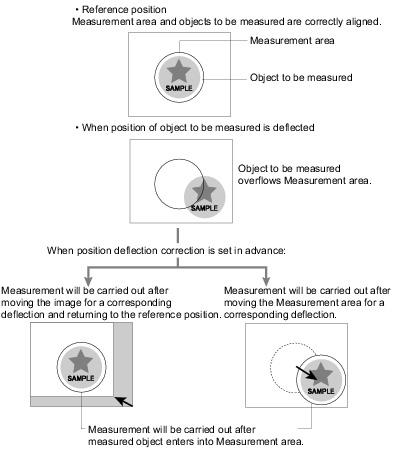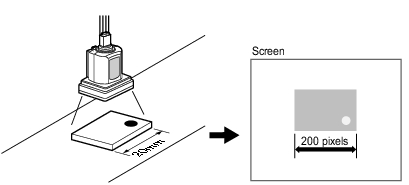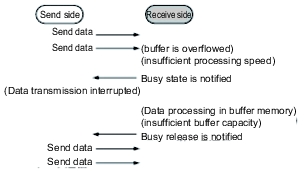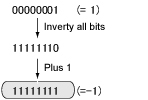Terminology Explanations
Position compensation
When the location and direction of measured objects are not fixed, the positional deviation between reference position and current position is calculated and measurement is performed after correcting.
Please select processing items that are appropriate to the measurement object from processing items that are related to position compensation.
Intelligent camera (with lighting function)
Cameras with a dome-shaped light can also be controlled with the controller. This is beneficial when the effects of ambient light are to be avoided and when it is desirable to shorten the lighting setting time.
For details, see "Intelligent Camera (with Lighting Function)".
"Intelligent Camera (with Lighting Function)".
For details, see
Reference position
The point that is always the reference. If the location of the registered model is different from the reference position, the setting should be changed in [Ref. position].
Calibration
This refers to conversion of measured pixel unit dimensions to actual dimensions.Setting the relationship between actual coordinates and camera coordinates enables conversion of measurement results in pixel units to actual dimensions.
To output measured values converted by calibration to external devices, set "Calibration" in "Output parameter" of each unit to "ON".
For example, in the case of an object that measures 20 mm wide and has a 200-pixel width in the measured image, calibration is performed as follows.
20 (mm) / 200 (pixel) = 0.1 (mm/pixel)
In other words, 1 pixel (pix) in the camera coordinates corresponds to 0.1 mm in actual size.
To output measured values converted by calibration to external devices, set "Calibration" in "Output parameter" of each unit to "ON".
For example, in the case of an object that measures 20 mm wide and has a 200-pixel width in the measured image, calibration is performed as follows.
20 (mm) / 200 (pixel) = 0.1 (mm/pixel)
In other words, 1 pixel (pix) in the camera coordinates corresponds to 0.1 mm in actual size.
Measurement flow
A measurement processing series is called a measurement flow. You can combine processing items to create measurement flows.
Detection point
This is the point that specifies the coordinates of which part of the model are to be output by the search and ECM search processing item. The initial value is at the center of a model.
Candidate
With regards to search based processing items (search, flexible search, ECM search, classification, character inspection, model dictionary), both a rough search, which is a search over the entirety of the measurement region, and a detailed search, which is a search in areas of the rough search where correlation was high are performed. The candidate point is the point at which an area becomes a candidate for "Detail search". The candidate point level represents the rough search correlation value. If stable search of a model is not possible, set the candidate point level lower.
Sub-pixel
Points that are formed finer than pixels.In the case of search processing, if sub-pixel processing is turned on for measurement parameters, interpolation measurement is performed using sub-pixel units.
Scene
Measurement processing that is created with a combination of units. Preparing a scene for each measurement object or measurement content makes it easy to change measurements.
 What Is a Scene?
What Is a Scene?
Scene group
32 units are incorporated into a scene for sorted measurement.This is convenient for managing scenes on a per category basis.
 What Is a Scene Group?
What Is a Scene Group?
Center of gravity
The images with white pixels are cut into paper of a certain thickness, and when one point is used to support the paper, the point which enables the paper to balance is called the center of gravity. The center of gravity of a circular object is the center of the circle, the center of gravity of a rectangle is the intersection of two diagonal lines.
Processing item
Single units that constitute measurement processing. Scenes (measurement flow) are created by registering processing items in units.
Processing unit
A unit that constitutes measurement processing.Scenes (measurement flow) are created by setting processing items in processing units.
 Creating a Scene
Creating a Scene
Correlation value
0 to 100 are used to represent the degree of similarity with an acceptable object.Namely, higher values indicate higher degrees of similarity.
Flow control
If the processing speed of the receiving side is slower than that of the sending side when data is being transferred, the receiving side will send interruption commands to the sending side or send re-admittance commands and then adjust the transmission speed.
There are two flow control methods: "Hardware Flow Control" and "Software Flow Control". With this product, "Software Flow Control" is used to adjust transmission speed.
Model
The image pattern that serves as the inspection target. Characteristics portions are extracted from images of the object and registered as model registration.
Unit
2's complement
Binary numbers are generally used to represent negative numbers.
Negative numbers are expressed by "Inverting all bits of a positive number and adding 1 to the result".
(Example) "-1" is expressed as 2's complement
"-1" can be calculated by "0-1".
Negative numbers are expressed by "Inverting all bits of a positive number and adding 1 to the result".
(Example) "-1" is expressed as 2's complement
"-1" can be calculated by "0-1".
There are methods for simple calculation without performing this kind of computation.
For instance, "Negative number = inverting all bits of a positive number and then adding 1 to the result".
For instance, "Negative number = inverting all bits of a positive number and then adding 1 to the result".




